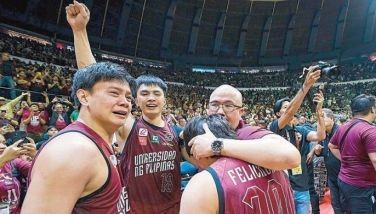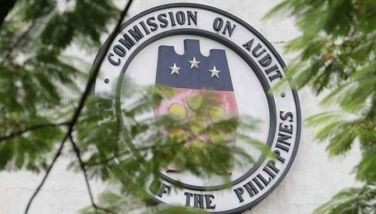When can we have doctors who are healers?
During the past several weeks, I have been featuring thought-provoking items from that highly-informative book, Choices in Healing, written by Michael Lerner, which Inday Santiago, a leader in the Filipino women's movement, bought for me when she went to the United States several months ago. My main objective in citing portions of this explosive book is to convey Lerner's main message: That doctors should allow patients to participate in the healing process. Which means that patients should be told of all options, of all alternatives, before their bodies are cut up by surgeons or before deadly chemicals are injected into their veins. Which means that the patients should become major participants in their healing.

Last Wednesday, a young doctor, who is now training at a leading Metro Manila hospital, sent to me a letter whose contents are nourishing food for thought. Several months earlier, he had sent to me a note, about the current local political landscape, and it was written so graphically and so well that I commented that he, the doctor, should have been a journalist instead.
I did not know this doctor personally, until he approached me last Wednesday afternoon, while he was doing his job at the hospital. He told me he was the one who had sent the excellently-crafted letter that I had featured in my column. I did not realize he was that young, until I personally met him. But although young in age, he is definitely mature and old in wisdom, a fellow whose thoughts should be disseminated far and wide, to help make the medical profession truly lofty and ennobling.
In his recent letter to me, he asked that his name be withheld. I know why. For saying what he said, many of his colleagues in the medical profession, especially those who are slaves of their scientific beliefs, might term him a heretic or an apostate. It has happened in the United States. Some American doctors who had broached ideas on alternative or adjunctive treatment were either banned from practicing the medical profession or termed as quacks.
As I said at the outset, the doctor's thesis is so relevant that I feel compelled to quote it, almost in its entirety. Let us listen to what this young doctor, who graduated from an old prestigious university, said:
Being a physician who always deals with patients afflicted with cancer, I cannot help but be made aware of the lessons our mentors have taught us since the first day of medical school. Medicine is both an art and a science. The science of medicine has progressed by leaps and bounds these past thousand years. From the days of Hippocrates and Galen, there have been gargantuan advances in the detection and treatment of every human ailment. In fact, this past century has even brought forth new diseases which the founders of my art have never seen.
I feel, however, that it is the art of the practice of medicine that has been lost on a good number of my colleagues. I do not mean to be judgmental on the bedside habits of the doctors who examine and treat patients, but I would like to remind them that when a patient comes for consultation with a physician, it is tantamount to saying, "I leave my life in your hands."
This trust is most seen in patients who have cancer. While cancer is not the number one killer disease worldwide, and even in our country, no other disease -- save for HIV/AIDS -- strikes more fear, depression and hopelessness in a person's heart. This is something that doctors must always be made aware of.
I feel that in the process of becoming a "physician-scientist," the "physician-healer" has somewhat lost its luster. I choose the word "healer" over the term "clinicians." I feel it is more appropriate that while the science of medicine can cure disease, it is the art of medicine that heals a person. One need not possess the title "M.D." after his name to be a healer, but all those with the initials affixed to their names should strive to be one; and one very important aspect of healing is to provide hope. There is, however, a thin line that separates the providing of hope and falsely raising a patient's expectations. Physicians, especially oncologist, tow that line everyday.
I realize that when confronted with a patient with a disease such as cancer, physicians will always quote statistics. While these statistics may not seem like much to this lay person, it is these statistics that usually guide treatment decisions of the physician. However, I wish to state that what is lost sometimes in the treatment decision-making is the participation of the patient.
Physicians may be so engrossed in the present guidelines, new developments, and statistics that they sometimes fail to include the most important person in the decision-making process: The patient. This is another message I would like to impart to my colleagues in the care of their patients: To respect the sacredness of the patient's decision. It may be contrary to current medical teachings, but in cases such as cancer -- especially terminal cancer -- wherever there is that faintest ray of hope, those who have been trapped in the abysmal darkness will always follow it. It is our duty as healers to provide that ray of hope. Let us not forget that we must cure sometimes, but comfort always.
I received a letter from Fr. Norberto L. Carceller, regarding an incident that happened at 8:45 a.m. on Tuesday, April 18, during Holy Week. A Mitsubishi L-300 service van (plate number ULC 255) ferrying several PWDs (Persons with Disabilities), owned by the Community-based Rehabilitation (CBR), a program under the auspices of the Vincentian Missionaries Development Foundation, was bumped by a Toyota Corolla car, with plate number 16 NCR, owned by Judge Leticia Morales of the Makati Metropolitan Trial Court.
According to Fr. Carceller, Judge Morales, who was aboard her car when the incident happened, was initially apologetic. She even brought the injured PWDs to the East Avenue Medical Center for medico-legal examination, although she did not pay for the X-ray results. But eventually, said Fr. Carceller, Morales denied any responsibility for the incident and has even given an opposite version of what happened.
As of now, the PWD service van, which was badly damaged, has remained in a useless condition. Morales has offered to pay part of the cost of the van's repair, but with the condition that the CBR will admit accountability for the incident.
"The incident has become a heavy baggage and paralysis from different angles. We may have enough bases to bring the case to court but are just realistic and mindful of the further delays and damages that judicial processes would cause. May we then appeal for your valued support to voice out this clamor for justice for the disadvantaged PWDs in the hands of a professed and practicing justice-enforcer, who is supposed to be the defender of rights and the mirror of equality, and who should uphold and give justice where it is due," said the Payatas Disabled Persons Organizations, with contact address at 221 Tandang Sora Avenue, Quezon City, the office of the Catholic-organized Vincential Missionaries Social Development Foundation Inc.
Art A. Borjal's e-mail address: <[email protected]>
- Latest
- Trending





























